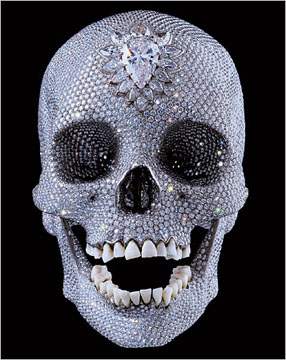Damien Hirst was born in 1965 in Bristol, UK. He lives and works in London and Devon. For the past two decades he has been widely acknowledged as the most
important and influential artist of his generation.
For the Love of God' is a platinum cast of a human skull encrusted with 8,601 flawless diamonds. Set on the forehead is a large, pear-shaped light fancy pink diamond, called the Skull Star Diamond. The teeth are from the original skull. It was hailed worldwide and generated enormous publicity when first unveiled in 2007 at London’s White Cube. Dutch art historian Rudi Fuchs described it as “a supernatural skull, almost heavenly”. He relates Hirst’s work to the memento mori and vanitas motifs popular in the Dutch Golden Age. For the Love of God and Hirst’s personal selection of works from the Rijksmuseum collection reveal how fear of death has provided a theme in art over the centuries. Appropriately, For the Love of God appears in the Philips Wing, surrounded by the Masterpieces of the Golden Age.
Damien Hirst: “As an artist I try to make things that people can believe in, that they can relate to, that they can experience. You therefore have to show them as well as possible.”The human skull used as the base for the work, bought in a shop in lslington, is thought to be that of a European living between 1720 and 1810. The work's title was supposedly inspired by Hirst's mother, who once asked, “For the love of God, what are you going to do next?”
Hirst stated the idea for the work came from a Aztec turquoise skull at the British Museum.
Hirst said that the work was sold on 30 August 2007, for £50 million, to an anonymous consortium. Christina Ruiz, editor of The Art News paper, claims that Hirst had failed to find a buyer and had been trying to offload the skull for £38 million. Immediately after these allegations were made, Hirst claimed he had sold it for the full asking price, in cash, leaving no paper trail.
Reference:
Wikipedia, the free encyclopedia
Hirst defiantly showed he has money by using expensive diamonds in this piece of work, which states he is a very wealthy man. Diamonds are very expensive because they are a timeless stone witch is hard to come around. People attactchment to diamonds become very strong thinking diamond are everything they start to become emotionally attached to these small objects and would do any thing to get their hands on it by trade or killing people to get a hold of a expensive timeless stone. Hirst artwork is a timeless piece, which will show that he is a wealthy man for centuries to come.

I think Hirst was possibly trying to show more than just his wealth with this artwork, though I find the most interesting aspect to be the diamonds and the way they contrasting against his other artworks (mainly his pickled animal). The piece to me is more of a contrast between death and glory. Perhaps he’s showing a metaphor for the consequences of greed of the lengths people will go through to obtain wealth. Perhaps it’s even a statement about art itself, and whether people will see the message or just the diamonds? The fact he sold it for $50m, when it was reported there was an offer for $100m might state money wasn’t the main focus for him, (though he did make a huge profit).
ReplyDelete